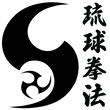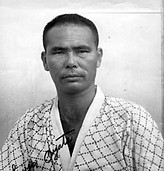
ZENKOKU RYUKYU KEMPO RENMEI
Traditional Okinawan Karate







Taika Oyata's Journey to Ryu-Te
by Hanshi Albert O. Geraldi
Why did you choose to study Ryukyu Kempo?
Over the past few decades, the many systems of martial art seemed to have evolved into one big melting pot; whereby most people today are unaware of the distinction in style or lineage. Having no idea myself at one time of the different styles, I believe it was destiny that led me to choose Kempo.
One day in my early twenties, I wandered down an obscure muddy back alley in Makiminato, a small Okinawan Village; and found inside a non-descript concrete building, Master Seiyu Oyata sitting cross-leg on a stool in front of the dojo. That was the beginning of my journey into the martial arts.
Why did Master Nakamura call his style “Okinawa Kempo?”
Many mistake kempo and karate to be one and the same or use the term “kempo” generically for “karate.” This is not true. Ancient Masters, such as Funakoshi and Choki Motobu, understood the difference between the two and even wrote about this in their books.
Okinawan calligraphy for “karate” means “empty hand.” For “kempo” the characters mean “fist law” or the older generation recognize the characters as “Chinese hand.”
Master Shigeru Nakamura’s teachers studied under a Chinese Ambassador to Okinawa (whose name may have either been Ku San Ku or his form was called Ku San Ku).
In any event, Master Nakamura decided to call his system “Okinawa Kempo” (Okinawa-Chinese Hand), and established his organization as “All Okinawa Kempo Karate-Do Association” clarifying that Kempo was a form of empty hand fighting.
Karate, as we know it today, was developed on Okinawa with roots going back to Ancient China.
The names of the original 12 katas had no meaning in the Japanese language; therefore, it is my belief the kata names may have either been in the old Okinawan dialect or may have been rooted in Chinese origin. For example, Chizi-Kun-Bo, “Kun” means “Bo” in Chinese or Nai-Han-Chi, “Chi” is the Chinese equivalent of “Ki" which is Japanese.
Around 1937, when Funakoshi began teaching in Japan, the names of the katas, for better recognition, were changed to Japanese. Shodokan, the Japanese style taught by Master Gichin Funakoshi, had its foundational roots in Kempo.
The flowchart below illustrates the transition of martial art knowledge from China down to all of Europe and America.
If Karate came from China, why is it different from Kung-Fu?
Chinese martial arts, particularly Kung-Fu, have long held philosophical and spiritual significance within the culture.
Along with this, the Chinese martial arts grew alongside the ideas of Confucianism and Taoism during the Zhou Dynasty (1045 B.C.- 256 B.C.) and beyond, not in isolation from them. For example, the Taoist concept of Ying and Yang, the universal opposites, ended up being tied in a large way to the hard and soft techniques that make up what is kung fu. The arts from flower arranging to archery including all boxing arts also became a part of the concepts of Confucianism, as they were tied to the ideal things people should practice.
From the late 1800’s to the early 1900’s, the Boxer Rebellion broke out in China; their goal was to remove foreign influence from China. “Boxers” was a name that foreigners gave to a Chinese secret society known as the Yihequan (“Righteous and Harmonious Fists”). The group practiced certain boxing and calisthenic rituals in the belief that this made them invulnerable.
After the rebellion had failed, the Dowager Empress Cixi ordered the purging of all the Martial Arts Schools and execution of teachers especially the leaders of the revolt, emphasizing Kempo (fist law or doctrine), which put an end to this hard system of boxing in China.
In the early 20th century, another purge was instituted by Mao-Tse-tung and his Communist Red Guard, destroying all cultural symbols.
What is the significance of these events?
By this time in history, karate had already been well established on Okinawa mainly due to their trade relations with China dating back as far as the 14th Century.
The martial arts were considered to be a secret art. For survival reasons alone, ancient martial arts were always taught in secret. Even as recently as fifty years ago, some schools on Okinawa would not teach Americans; even Chinese Kung-Fu studios in New York City would not accept American students.
Teaching in secret resulted in a minimal dissemination of information which ultimately allows the teacher to distort what they teach. When students begin training, they think they are entering a “doctoral program,” so to speak, when they seek to achieve Black Belt status, but the information they really learn after years of practice amounts to a basic First Aid course.
Due to this lack of information, down through the years, much of what is now being taught is just that – basic information – even to the point of being newly invented.
The truth is often difficult to accept as it sometimes conflicts with what we have for so long been hearing and practicing. In knowing and accepting the truth, the question is “Can you make the decision to live accordingly with or without it?” Remember: making such a decision, in any walk of life, can affect all future decisions and outcomes.
Then, if the art is so secret, why would the Okinawans even begin to teach karate?
From the mid-to-late fifties, the American Armed Forces began a physical education program for military personal, which included martial arts.
Okinawan karate instructors were invited to teach their art and were paid each month five dollars per student. Some karate instructors actually traveled to the bases to teach. This not only became a financial windfall for the teachers; the program had increased the number of schools on the Island.
Even though karate was becoming a popular sport, the meaning of the moves (“Bunkai”) were being withheld from foreign students. The secret is in the meaning.
What are kata’s?
According to Webster’s Dictionary, Kata is “a set combination of positions and movements (as in karate) performed as an exercise.”
Kata’s are the most effective original techniques of the masters we were never meant to learn. They are movements placed in a certain sequence to be memorized and practiced.
Katas were usually practiced in private or, on rare occasions, only to students the master approved of. The only time techniques were ever revealed were in either an actual match defending life or reputation. As a matter of pride, when Okinawans teach kata, they insist the form be taught and performed correctly.
If you ever watch a kata performance and recognize it, but it seems a bit different than what you have learned, it is probably due to the individual instructor’s personal training and his/her interpretation of technique.
Keep this in mind: The forms taught by Master Nakamura are the most accurate and are relatively unchanged. Therefore, Kata’s taught by our system’s teachers are more accurate than the version you are seeing.
Who was Master Seiyu Oyata?
There are three original letters in my possession written by three Okinawan
Masters: Shihan Toma, Seitoku Higa and Master Seikichi Ueihara in Japanese
and later translated to English. Written as character references over fifty years
ago these letters were sworn statements affirming Master Seiyu Oyata’s ability,
power, skill and knowledge as a teacher.
Master Seikichi Ueihara, the patriarch of the Motobu system and considered to be an Okinawan national treasure, wrote in his letter that Mr. Oyata was “one of four of the last great Kempo masters still alive.”
Few can claim the remarkable years I had training with Taika, who was then only thirty-six years of age and a fifth dan, in his Makiminato Dojo. My first experience with Taika in his dojo was being kicked in the head by him while wearing bogu equipment.
Sometime later, after Taika broke his right hand (his right index finger knuckle pushed half way up his hand), he experimented with second and third knuckle punching techniques, but was unsuccessful and from that point on he started stressing open hand techniques.
As his kicks gradually lowered, he focused more on self-defense and seminars saying, “Real self-defense is different from sport fighting”. Here he meant no-contact sport fighting that was already well established in the U.S.
Kumite, on the other hand, is foundational in the practice and testing of skill in martial arts. Kumite literally translated means "grappling hands" and is the part of karate in which a person trains against an adversary, using the techniques learned from kata. Full-contact Bogu Kumite is more like real self-defense.
Why change the name from Okinawa Kempo to Ryukyu Kempo?
In 1969, after Master Nakamura’s death, his family reserved the rights to the name “Okinawa Kempo.” In 1975, myself and two of Oyata’s other American students changed the name to “Ryukyu Kempo”.
Prior to arriving in the U.S. in 1976, Taika was using Masters Shihan Toma and Ueihara organization’s name “Ryukyu Karate.” After Taika arrived in the U.S. in 1976, he adopted the name that we had established.
After years passed, he became disheartened with the misuse and plagiarism of the system’s identity. He began to believe his legacy would be better served in having his own system name.
Who was the man - Taika?
Few people understand the complexity and depth of this man outside of being the great Kempo Master and his teaching experience.
Before becoming an American citizen, on Okinawa he had held other jobs, distributing food and supplies for the U.S. government; a diesel mechanic, a salesman, and a bouncer for the Tea House owners in his area.
He lost three brothers to war, was drafted and became a Japanese Lieutenant at the age of sixteen. He had a son who died in a motorcycle accident in Okinawa, he raised his brother’s children a niece and nephew.
Who is the Legend?
Taika’s mission here in the United States, first was economic survival. Secondly, he wanted to present the unique concepts of Okinawan Kempo never revealed before. His rare perceptiveness gave insight to many instructors who had only experienced the rudiments of martial arts.
From his years of teaching experience, Taika grew justifiably wary of other karate instructors. As a result, he undertook to employ change and sometimes misdirection in teaching his techniques which caused some confusion among the ranks. To hold the student’s attention, though, he had to drop nuggets of gold every so often.
On October 16, 1993, Taika was awarded masters grade by the United States Okinawan Cultural Society. In 1994, he formed his Shin-Shu-Ho-Ryu organization.
Taika has given much over years, not only to his students, but to others within his community through his charitable works. We all knew Taika Seiyu Oyata in different ways.
He was a complex, multi-faceted person. Those who knew Taika would describe the part of the man and teacher they knew best. As a teacher, he is held in high-esteem by his students and recognized world-wide for his contribution to the martial arts. As a businessman, he is well-respected by other leaders within the martial arts industry.
Which path of study will you decide to take?
The decision depends, as mentioned before, either on choosing the path paved by authentic teaching or one of inventive fantasy. Remember, authentic teaching derives from history and the Masters who originated their forms which are the most accurate.
I and my senior students have always kept faithful to the teachings of the way of Ryukyu Hands, and we will continue to do so in memory of our legacy.
* * *